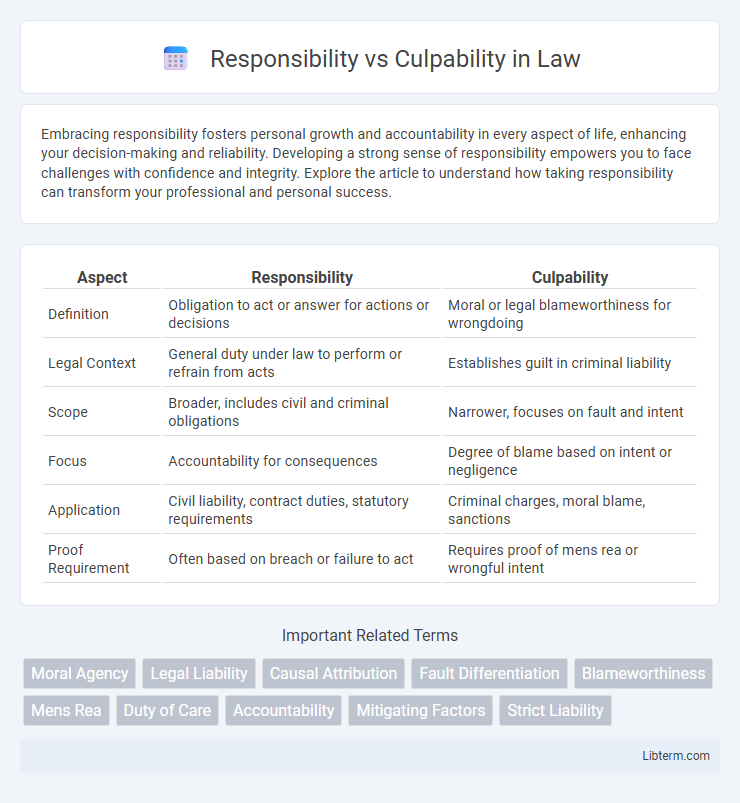Embracing responsibility fosters personal growth and accountability in every aspect of life, enhancing your decision-making and reliability. Developing a strong sense of responsibility empowers you to face challenges with confidence and integrity. Explore the article to understand how taking responsibility can transform your professional and personal success.
Table of Comparison
| Aspect | Responsibility | Culpability |
|---|---|---|
| Definition | Obligation to act or answer for actions or decisions | Moral or legal blameworthiness for wrongdoing |
| Legal Context | General duty under law to perform or refrain from acts | Establishes guilt in criminal liability |
| Scope | Broader, includes civil and criminal obligations | Narrower, focuses on fault and intent |
| Focus | Accountability for consequences | Degree of blame based on intent or negligence |
| Application | Civil liability, contract duties, statutory requirements | Criminal charges, moral blame, sanctions |
| Proof Requirement | Often based on breach or failure to act | Requires proof of mens rea or wrongful intent |
Defining Responsibility and Culpability
Responsibility refers to the duty or obligation to perform or manage a task, often linked to roles and accountability in professional or social contexts. Culpability denotes the degree of blame or guilt attributed to a person for a wrongful act, emphasizing moral or legal fault. Understanding the distinction between responsibility as an assigned role and culpability as the measure of fault is crucial in legal, ethical, and organizational discussions.
Key Differences Between Responsibility and Culpability
Responsibility refers to the duty or obligation to complete a task or uphold standards, often linked with roles and accountability without necessarily implying fault. Culpability denotes blameworthiness or guilt for a wrongdoing, usually established through intent or negligence in causing harm. Key differences include that responsibility centers on assigned duties, while culpability focuses on moral or legal fault for a specific wrongful act.
Historical Perspectives on Blame and Duty
Historical perspectives on blame and duty trace back to ancient legal codes like Hammurabi's, which established clear distinctions between responsibility and culpability by assigning penalties based on intent and outcome. In medieval societies, doctrines of moral and legal responsibility evolved, emphasizing the individual's duty to uphold social and religious norms while attributing culpability to willful transgressions. Enlightenment thinkers further refined these concepts, promoting the idea that responsibility encompasses a broader social obligation, whereas culpability involves direct fault or guilt in causing harm.
Legal Interpretations: Responsibility vs. Culpability
Legal interpretations distinguish responsibility as the obligation to answer for an action or its outcomes, whereas culpability refers to the degree of blameworthiness or fault assigned to an individual. Responsibility may exist without culpability, such as in strict liability cases where a party is held accountable regardless of intent. Culpability requires proving intent or negligence, impacting the severity of legal consequences and sentencing in criminal law.
Moral and Ethical Dimensions
Responsibility involves an ethical obligation to act or make decisions that align with moral principles, emphasizing accountability regardless of intent. Culpability specifically addresses moral blameworthiness for a wrongful act, highlighting the degree of intent or negligence involved. Understanding the distinction clarifies how ethical evaluations assign praise or blame in both personal and professional contexts.
Real-Life Examples: Assigning Responsibility and Culpability
In real-life scenarios, responsibility involves the duty to manage tasks or roles, such as a manager overseeing project timelines, while culpability refers to the blameworthiness in case of failure or wrongdoing, like a driver at fault for a traffic accident. For instance, a company's CEO is responsible for corporate governance, but culpability arises if negligence leads to financial fraud. Understanding the distinction aids in fair legal judgments and accountability in both personal and professional contexts.
The Role of Intent and Negligence
Responsibility in legal contexts often involves duty and accountability, whereas culpability centers on the moral or legal blameworthiness tied to intent. Intent plays a crucial role in establishing culpability, as deliberate actions typically warrant greater sanctions, while negligence reflects a failure to exercise reasonable care without necessarily implicating intent. Distinguishing between intentional wrongdoing and negligent conduct helps determine appropriate liability and punishment in both criminal and civil law.
Collective vs. Individual Accountability
Responsibility often refers to collective accountability where groups, organizations, or communities share the duty for actions and outcomes, emphasizing shared goals and social roles. Culpability focuses on individual accountability, pinpointing personal fault or blame in ethical or legal contexts, which requires assessing intent and specific contributions to wrongdoing. Distinguishing between these concepts is crucial for justice systems and organizational management to assign appropriate consequences and foster ethical behavior.
Responsibility and Culpability in the Workplace
Responsibility in the workplace refers to the duties and tasks an employee is expected to perform, reflecting accountability for their role and actions within an organization. Culpability involves the degree of blame or fault assigned when a mistake or failure occurs, often linked to negligence or intentional misconduct. Understanding the distinction between responsibility and culpability helps clarify expectations and supports effective management of performance and disciplinary actions.
Navigating Consequences: Lessons and Prevention
Responsibility involves accepting accountability for actions and their outcomes, while culpability emphasizes fault and blameworthiness in adverse situations. Navigating consequences requires understanding the distinction to implement effective lessons learned and preventive measures that foster accountability without unjust punishment. Organizations and individuals enhance risk management by promoting responsibility, encouraging transparency, and developing strategies to prevent recurring issues through proactive behavior.
Responsibility Infographic

 libterm.com
libterm.com